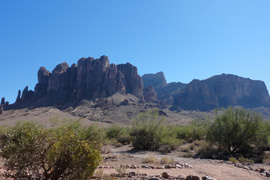[Source: Mary Jo Pitzel, Arizona Republic] – There’s no money to construct boat ramps at Lake Havasu State Park or fix a leaky roof at Kartchner Caverns’ visitor center.
Nor are all Arizona state parks open year-round, or even all week.
And any thought of expansion is a pipe dream, because the parks have gone five years and counting without any money from the state’s general fund.
But, really, things are OK with state parks. So says the agency director, as well as friends and supporters of the 31-property system, who rallied to help keep parks open in the face of apparently irreversible budget cuts.
Kept afloat by partnerships, fee increases and volunteer labor, state parks are a bit like the tattered flag that flaps over a hard-fought battleground. They’re still there. But questions persist about how long the alliances that sustain them will last.
“The business end of Arizona State Parks is very challenging,” said parks director Bryan Martyn. Without general-fund support, which was cut in 2009, it’s hard to predict how much money the system will have from year to year, he said.
For now, partnerships have worked well, said Bill Meek, president of the Arizona State Parks Foundation. But he wonders how long that will last.
“It’s debatable how long some of these partnerships will go,” he said. “Most are local governments, which have their own (budget) issues.”
Some of these partners question why local government is picking up the tab for a state operation, Meek added.
In Flagstaff, a partnership knitted together under the threat of shuttering a historic Arts and Crafts-era home has kept the Riordan Mansion State Historic Park open. The Arizona Historical Society took over operation of the 13,000-square-foot mansion, with assistance from the Riordan Action Network, a network of community supporters.
“State Parks (crews) were coming up here, and they were measuring all the windows for plywood,” said park manager Joe Meehan, recalling the days when the park teetered on the brink of closure. If the house is closed for a year, it reverts to the Riordan family, according to a stipulation written into the deed when the house was turned over to the state in 1986.
Supporters convened community meetings, and out of that grew the action network and a partnership with the historical society.
Meehan, a curator at the nearby Pioneer Museum in Flagstaff, split his time and moved to the mansion to take over as park manager.
“This park is very special to the community,” he said. “It is a showpiece, and it is a piece of art.”
It also is a big piece of Flagstaff history, built at the turn of the 20th century by the two brothers who ran an area lumber mill. Tim and Michael Riordan, along with their spouses, built two mirror-image houses, connected by a large common area they called “the cabin.” The sprawling mansion was nicknamed the “ultimate duplex,” boasting 40 rooms.
The mansion, one of several historic sites in the state parks’ portfolio, fit well with the historical society’s mission, said Bill Peterson, the historical society’s northern-division director.
The society signed a three-year agreement to run the mansion, saving it from closure at the height of the state’s deep budget cuts. The deal has been renewed for another three years.
Gwen Groth helped found the Riordan Action Network in 2009, propelled by her love of history and the mansion’s role in Flagstaff’s story.
The network counts a few hundred members, some even stretching to the Riordans’ home country of Ireland, but it has fallen to a small corps of locals to raise the money that has helped the mansion keep its doors open.
To date, the network has raised $70,000. In the early days, it paid for roof replacement and other maintenance costs.
But Groth said it’s been nearly a year since the group has had to contribute operating expenses, since the park was doing well on fees, concession proceeds and support from the historical society.
That’s freed up money for special projects, like supplies for the mansion’s many gardens and lighting for the courtyard, the site of weddings and other special events.
Between the network support and the partnership with the historical society, Riordan Mansion is faring well. Admission fees and collections from other events are up. The park got a big boost last fall when the federal government’s budget stalemate closed Grand Canyon National Park. Tourists were looking for alternatives, and Riordan was an easy option, Meehan said.
But is this arrangement strong enough to keep the park running in the long run?
“It’s tough,” Meehan said. “But it’s working right now. It’s worked for three years.”
That sense of uncertainty is common among other parks supporters.
Martyn said the parks have benefited from a $1 million appropriation that lawmakers negotiated in this year’s budget. A bill pushed by Sens. Sen. Steve Pierce, R-Prescott, and Steve Farley, D-Tucson, took a portion of the interest earned on the state’s “rainy-day fund” and split it evenly between the parks and the Commission on the Arts.
Martyn said the money allowed the agency to bring electricity to campgrounds at three parks, making them more attractive to visitors with recreational vehicles and campers.
“That $1 million will turn into $5 million over the next five years,” Martyn said, counting on an uptick from visitors with RVs.
However, there are no indications the appropriation will continue next year. And a reliable source of parks funding — money from boat-registration fees — could be redirected to county governments for lake improvements if House Bill 2149 becomes law.
Some of the partnerships are dialing back their financial contributions. For example, the Hopi Tribe used to provide $175,000 a year to Homolovi State Park, which is on the reservation. It’s now $50,000, Martyn said.
For the past three years, Yavapai County contributed $90,000 a year to help support the five state parks within its boundaries. Now, it’s nothing.
“They don’t have the money,” Martyn said.
As the support ebbs, the needs pile up.
The parks have $4 million in capital needs. Projects on the waiting list range from running a water line from Benson to Kartchner Caverns State Park to building gallows for Tombstone Courthouse State Historic Park.
At the Parks Foundation, Meek takes some comfort from the business plans that have been developed for each of the parks. They are designed to help the parks maximize their revenue and make them self-sustaining.
He believes parks need to forget help from lawmakers “as long as the Republicans are running the Legislature.”
The parks’ long list of needs makes self-sufficiency a difficult goal.
“They have a whole bunch of capital needs just waiting to pounce on them,” Meek said. “They’re one circumstance from being shut down.
“What happens when the wastewater system at Buckskin (Mountain State Park) breaks and starts spewing into the Colorado River?”



You must be logged in to post a comment.